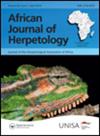饮食专业化断言的检验——以capensis Apallactus的饮食为例
IF 0.9
4区 生物学
Q3 ZOOLOGY
引用次数: 2
摘要
摘要:由于缺乏精确描述许多生物体饮食所需的详细自然史信息,通常会对这些饮食进行笼统的描述。这些描述可能会变得教条,当这些数据可用时,应该用新的观测数据来挑战这些描述。我们测试了角蜈蚣食者(Apallactus capensis)作为食蜈蚣专家的特征,他们食用蜈蚣,而不包括其他猎物类型。我们解剖了62个保存完好的山核桃标本,并鉴定了胃内容物。15个标本共包含16个猎物,所有这些都可以识别为蜈蚣。采用模拟方法,我们计算了所有已知野生猎物项目(n = 21)是在一系列不同的模拟饮食下的蜈蚣。我们发现,如果吃角蜈蚣的人确实吃非蜈蚣猎物,他们很少吃。尽管所有报道的山蜈蚣猎物都来自Scolopendromorpha目,但一项对453份南非蜈蚣公民科学记录的调查表明,该目成员占所有观察结果的三分之二。这些数据不允许我们拒绝这样一种假设,即食角蜈蚣的人会根据遭遇的情况按比例吃掉不同的蜈蚣猎物。本文章由计算机程序翻译,如有差异,请以英文原文为准。
Testing assertions of dietary specialisation: a case study of the diet of Aparallactus capensis
ABSTRACT The lack of detailed natural history information required to precisely characterise the diets of many organisms often results in the use of generalised descriptions of those diets. These descriptions can become dogmatic, and should be challenged with novel observational data when those data become available. We tested the characterisation of cape centipede eaters (Aparallactus capensis) as centipede-eating specialists that consume centipedes to the exclusion of other prey types. We dissected 62 preserved A. capensis specimens and identified stomach contents. Fifteen specimens contained a total of 16 prey items, all of which were identifiable as centipedes. Taking a simulation approach, we calculate the probability of all known wild prey items (n = 21) being centipedes under a range of different simulated diets. We show that if cape centipede eaters do eat non-centipede prey, they do so very infrequently. Although all reported prey items for A. capensis are from the order Scolopendromorpha, a survey of 453 citizen science records of South African centipedes suggests that members of this order account for two thirds of all observations. These data do not allow us to reject the hypothesis that cape centipede eaters consume different centipede prey proportionally to what the encounter.
求助全文
通过发布文献求助,成功后即可免费获取论文全文。
去求助
来源期刊

African Journal of Herpetology
ZOOLOGY-
CiteScore
3.00
自引率
6.70%
发文量
15
审稿时长
>12 weeks
期刊介绍:
African Journal of Herpetology (AJH) serves as an outlet for original research on the biology of African amphibians and reptiles. AJH is an interdisciplinary journal that publishes original articles and reviews from diverse fields and disciplines, such as conservation, phylogenetics, evolution, systematics, performance, physiology, ecology, behavioural ecology, ethology, and morphology.
The Journal publishes two issues a year. There are no page charges .
 求助内容:
求助内容: 应助结果提醒方式:
应助结果提醒方式:


